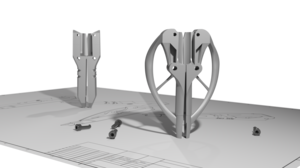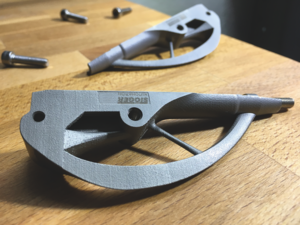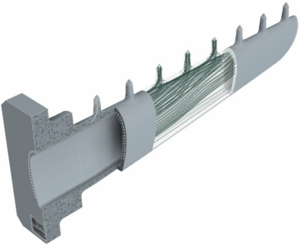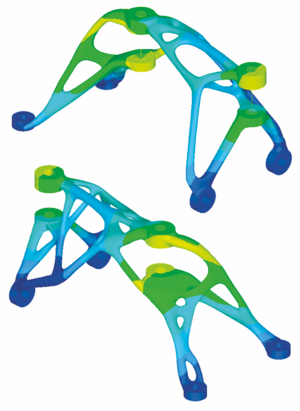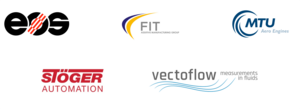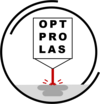
OptProLaS
Component Optimization Under Consideration of the Process Influences During Selective Laser Melting
Keywords
Additive Manufacturing, Selective Laser Melting, Topology Optimization, Process Optimization
Problem
Additive manufacturing offers the maximum possible freedom of design in construction, but also poses completely different challenges than "conventional" machining, forming or primary forming manufacturing processes. For example, components manufactured by additives often do not achieve the required dimensional accuracy. One of the main causes of this in additive manufacturing by means of laser beam melting is thermally induced distortion. Distortion can be reduced by modifying process parameters, pre-deformation of components or even individual design measures. However, the potential of design freedom is seldom sufficiently exploited at present in order to optimally design components to be manufactured using additives with regard to dimensional accuracy. Instead, these are often initially designed on the basis of "conventional" components. Measures to increase dimensional accuracy are only taken afterwards. In order to obtain dimensionally accurate components in the sense of "first-time-right" production right from the start, the construction must be combined with process simulation and design.
Goal
The aim of this research project is therefore to develop a procedure that effectively links the simulation of the additive manufacturing process with the design of the components and shows the potentials of additive manufacturing in comparison to classical manufacturing processes (Figure 1). The Institute for Machine Tools and Industrial Management (iwb) looks back on more than ten years of experience in the field of process simulation in laser beam melting.Machine Tools and Management Sciences (iwb) looks back on more than ten years of experience in the field of process simulation in laser beam melting. Currently, an open source software is being developed, which is already being used as a beta version in series production at MTU Aero Engines AG. It enables the numerical calculation of deformations and stresses during the manufacturing process. The results are analyzed in a structured way to investigate the design related causes of e.g. warpage. The results are then used for the design. For the design, methods with a high innovation potential are considered, which allow the creation of new component geometries. These are on the one hand innovation methods such as bionics, and on the other hand optimization methods such as topology optimization. These methods have already been successfully used for the design of additively manufactured components. For example, a bionic microtiter plate was developed at the Laboratory of Product Development and Lightweight Construction (LPL). For the effective use of the simulation results of the additive manufacturing process the construction and optimization methods are adapted. For example, topology optimization has so far only taken into account loads on the finished component during operation and not the boundary conditions caused by the manufacturing process.
Approach
The project is divided into six work packages (WP), which are carried out in cooperation between the two research partners (iwb, LPL) and the company partners.
In WP 1, several demonstrator components proposed by the partner companies will first be analyzed. The aim is to determine all relevant requirements for the components, in particular the geometry, functions and production.
The following two work packages (WP 2, 3) will be carried out in parallel. The aim is to develop a procedure for the integration of the process influencing variables of the additive
manufacturing process in the design optimization. For this purpose, prototypes of the demonstrator components are iteratively constructed using innovation and optimization methods (WP 3). In addition, the process understanding of bionic structures will be further developed (WP 2). The simulation results are then analyzed with process simulation to determine the design causes of deficits in dimensional accuracy.
These are then used for the construction of further prototypes (WP 3). In this way, the demonstrator components are improved step by step with regard to dimensional accuracy.
The consideration of the individual iteration steps enables the development of an efficient design process, innovation methods and optimization (WP 4).
The project results will be finalized in the three final work packages: For this purpose the optimized demonstrator components will be manufactured in WP 4. WP 5 focuses on linking topology optimization with process simulation and deriving a generally valid procedure. In WP 6, a general guideline for the integration of design and simulation is created.
While WP 2-4 mainly focus on the demonstrator components, the results obtained in WP 5 and WP 6 are analyzed and generalized on a more abstract level. The result is a guideline for the simulation and design of additively manufactured components as well as for the creation of a potential assessment of different
Construction methods.
